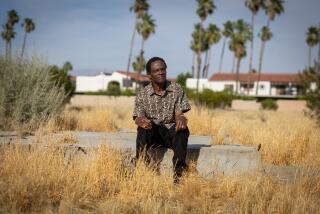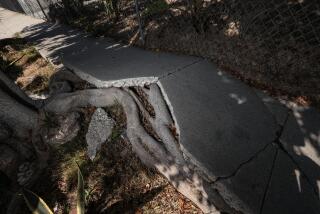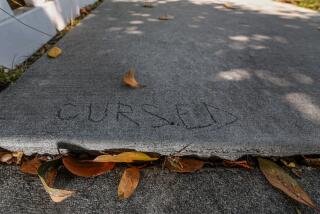Downey to Return $30,000 : Sidewalk Debate Ends in Refund to Developer
DOWNEY â The cityâs redevelopment director recommended against it. So did the city attorney. Nevertheless, a sharply divided City Council has decided to reimburse a local developer for $30,000 in sidewalk improvements in the heart of Downeyâs redevelopment district.
On a 3-2 vote, the City Council approved the payment last week to Cardono Square Ltd., which owns a redevelopment project that features a newly constructed five-story office building on the northwest corner of Firestone Boulevard and Downey Avenue.
The vote came after a heated debate in which one councilman suggested the payment was essentially a gift of public funds, while Mayor James Santangelo argued that the cityâs contract with developer Angelo Cardono was so poorly written that Downey had no other choice.
âIf the city (erred) in drawing up a contract that is so contradictory, we donât impose on a gentleman,â Santangelo said before the vote.
Opponents of the reimbursement argued that Cardono agreed in 1983 to free Downey from its obligation to pay for the sidewalk improvements in exchange for a $364,000 break on land the city sold him.
Less Revenue Expected
To make matters worse, opponents say, it could take Downey twice as long to recoup its investment in the redevelopment project because Cardono built something considerably less elaborate than the $5-million project called for in the agreement; that could cost the city thousands of dollars each year in tax revenue.
Cardono first signed a contract with the Downey Community Development Commission in 1979 for the Cardono Square redevelopment project, a planned $7-million commercial retail complex.
That agreement was renegotiated and the existing agreement was signed in 1983. By then, the value of the project had been scaled down to $5 million.
The shell of the building was completed about a month ago and workers are finishing the inside. Cardono paid $30,000 to put in new sidewalks along Firestone Boulevard and Downey Avenue.
City officials involved agreed that the 1979 contract included provisions obligating the city to pay for sidewalk improvements connected with the redevelopment project. But the section stipulating that the city reconstruct the sidewalks surrounding the project was dropped from the 1983 agreement.
Councilman Randall Barb, who was part of the city team that negotiated the 1983 agreement, said the provision was purposely omitted and the council action could be viewed as a gift of taxpayersâ money.
âWe Paid Handsomelyâ
âPart of those negotiations were that he (Cardono) would pay for the (sidewalk) improvements,â Barb said. âFor the benefit of not having to put in public improvements we paid handsomelyâ by selling him land for less than it cost the city.
The project was delayed by the recession and high interest rates. When the contract was renegotiated in 1983, the city sold Cardono some land for his project for $364,000 less than the city had paid, said Jim Cutts, director of community development.
âItâs a major intersection in our city, a very important corner,â Cutts said, explaining why the city was willing to absorb the higher costs. âWe saw it as a cornerstone to our redevelopment efforts.â
The project ended up costing the commission $509,335, including the discount on the land, demolition costs and the expense of relocating former tenants.
âThe fact is that the project cost us more,â Cutts said, and as a result the provision obligating the city to pay for sidewalk improvements was removed.
Cutts said Cardono was advised beforehand that the city wouldnât pay for the improvements because the existing sidewalks were safe, if not aesthetically pleasing.
When the vote came up Tuesday night Cutts, City Atty. Carl Newton and commission redevelopment attorney Mark Hubesch all advised against the $30,000 reimbursement.
Barb and Councilwoman Diane Boggs also accused Cardono of violating the 1983 contract because he did not build the $5-million project as agreed. As of Dec. 4, the value of building permits issued was $2.55 million, Cutts said.
Revenue Pegged on Value
The value is important because the commission receives tax revenue based on the value of the building, which eventually offsets the money it put into the redevelopment project. For example, a $5-million building would have generated $38,000 in additional annual tax revenue for the commission, while it could net as little as $13,000 per year on the downscaled project, Cutts said.
The final tax benefit the commission receives will be determined when the building is assessed.
âWeâre going to lose $25,000 a year if itâs valued at what the permits showed,â Barb said. âTo throw good money after bad . . . isnât right. Itâs wrong.â
But Santangelo argued that Cardono could reasonably expect to be reimbursed for the improvements considering the language in the 1983 agreement.
âI think what we have here is a contradiction,â he said. âThe man has made a major improvement to this city and he should be congratulated instead of chastised.â
Meanwhile, Cardono lauded the City Council for approving the payment.
âMy understanding was that they were supposed toâ pay for the improvements, he said. âOn Tuesday evening they sent out a signal to other prospective developers that the City of Downey honors its agreements.â
City Councilmen Robert Cormack and Roy Paul joined Santangelo in voting for the reimbursement, while Barb and Boggs voted against it.
More to Read
Sign up for Essential California
The most important California stories and recommendations in your inbox every morning.
You may occasionally receive promotional content from the Los Angeles Times.










